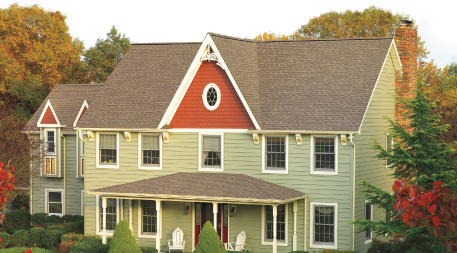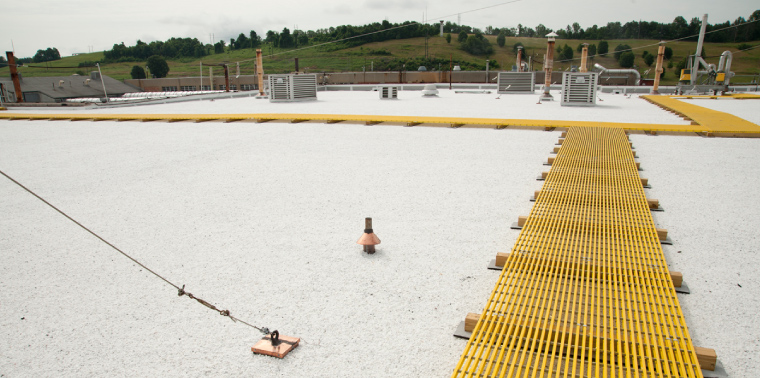December 16, 2013 — Millions of dollars and massive amounts of fossil fuels are spent cooling homes and buildings covered by conventional roofs that absorb sunlight, get as hot as 185 degrees and radiate that heat inside. Add to that the fact that sunlight-absorbing roofs contribute to the urban heat island effect, which increases air pollution, and it’s easy to see the need for something new. Luckily, there is promise for reducing this burden to the environment and economy — in cool roofs.
New cool roof technologies either have reflective elastomeric coatings or are made with reflective surfaces. Both reflect sunlight and radiate heat into the atmosphere rather than retaining it where it can increase the temperature of buildings and pavement.
Most nonresidential roofs are out of sight, so whatever color reflects the most heat is fine. In such cases, roofing with an opaque outer white layer or a white elastomeric coating is the best option.

With reflective granules embedded in the shingles, specially designed dark roofs can keep houses cooler than conventional roofing while retaining the aesthetic features important to homeowners. Photo courtesy of GAF Corp.
For residential roofs, however, homeowners can be opposed to the appearance of white roofs, so manufacturers have developed dark roofs that save energy through reflective shingles, tiles and other materials in various colors — many of which are ENERGY STAR-rated. Though still not as effective as white roofs, these recent innovations save much more energy than conventional dark roofs.
Significant Savings
The California Energy Commission reports that a 1,000-square-foot white roof will offset 10 tons of carbon dioxide over its average lifetime of 20 years. And according to the Lawrence Berkeley National Laboratory’s Heat Island Group, retrofitting all possible urban flat roofs to white and sloped roofs to cool colors in the tropical and temperate zones of the world would offset 24 gigatons of carbon over a 20-year span, or 1.2 gigatons per year — the equivalent of emissions from about 300 million cars. A National Center for Atmospheric Research study using a different model found similar results. The LBNL group also found that using cool roofs technology for new construction and replacement roofs in the U.S. could save more than $15 billion in energy over 20 years.
It’s not surprising, then, that cool roofs can be found across the United States. Volunteers recruited by a Queens-based not-for-profit energy efficiency business have applied reflective white coatings to over 4 million square feet of New York City’s roofs; the Seattle Central Library, most Walmart stores, Salt Lake City’s Olympic Oval, and the Y-12 National Security Complex in Oak Ridge, Tenn., all sport the technology.
But cool roofs aren’t just attracting attention in the U.S. A global coalition of India, Mexico, Japan, South Africa and the U.S. offers an open knowledge base of technical information and government policies and standards about cool roofs that has fielded inquiries from 126 countries. The U.S. is working with China to add cool roofs there, Europe’s Cool Roof Council has members from eight countries, and Montreal’s public works building, the Bank of India in Mumbai, the Cricket Club in Toronto, and the Technological Educational Institute in Crete, Greece, all have cool roofs.
Ongoing Research
Despite a wider acceptance of cool roofs and big advances in the technology, there is room for improvement. Working with the U.S. Department of Energy and roofing and coating manufacturers, LBNL is at the center of cool roof research.
In cooperation with CertainTeed, for example, the lab is now working to produce cooler asphalt shingles. It’s also working with Dow and the Oak Ridge National Laboratory to create white elastomeric roof coatings that stay clean as well as to develop exceptionally durable cool coatings, and with PPG to develop fluorescent cool dark pigments. Keeping roofs clean so reflectance remains high is a critical area of research.
Ronnen Levinson, a staff scientist at the LBNL, says keeping roofs clean so reflectance remains high is a critical area of research; possible solutions involve the addition of antimicrobial agents and photocatalysts to roofing materials. And Mas Subramanian, a researcher at Oregon State University, has discovered brilliant reflective pigments with yttrium, and is now searching for less expensive alternatives. Other ongoing cool roof research includes developing and testing fluorescent pigments for use in metal roofs and dark coatings.
As cities have grown and demand for energy efficiency increased, so too has interest in the use of reflective roofing. With emerging technologies making cool roofs even cooler, it’s a good bet we’ll be hearing even more about this innovative approach in the years to come. ![]()
UPDATED 12.21.13: The article has been updated to reflect the current state of LBNL cool-roof development collaborations.
Ensia shares solutions-focused stories free of charge through our online magazine and partner media. That means audiences around the world have ready access to stories that can — and do — help them shape a better future. If you value our work, please show your support today.
Yes, I'll support Ensia!

how do they affekt the temperature of the roof ?
how would a cool roof with solar panels look like ?